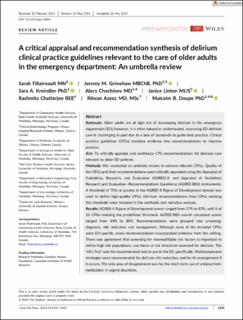| dc.contributor.author | Filiatreault, Sarah | |
| dc.contributor.author | Grimshaw, Jeremy M. | |
| dc.contributor.author | Kreindler, Sara A. | |
| dc.contributor.author | Chochinov, Alecs | |
| dc.contributor.author | Linton, Janice | |
| dc.contributor.author | Chatterjee, Rashmita | |
| dc.contributor.author | Azeez, Rilwan | |
| dc.contributor.author | Doupe, Malcolm | |
| dc.date.accessioned | 2023-11-17T08:59:56Z | |
| dc.date.available | 2023-11-17T08:59:56Z | |
| dc.date.created | 2023-06-29T14:06:02Z | |
| dc.date.issued | 2023 | |
| dc.identifier.citation | Journal of Evaluation In Clinical Practice. 2023, 29 (6), 1039-1053. | en_US |
| dc.identifier.issn | 1356-1294 | |
| dc.identifier.uri | https://hdl.handle.net/11250/3103129 | |
| dc.description.abstract | Rationale
Older adults are at high risk of developing delirium in the emergency department (ED); however, it is often missed or undertreated. Improving ED delirium care is challenging in part due to a lack of standards to guide best practice. Clinical practice guidelines (CPGs) translate evidence into recommendations to improve practice.
Aim
To critically appraise and synthesize CPG recommendations for delirium care relevant to older ED patients.
Methods
We conducted an umbrella review to retrieve relevant CPGs. Quality of the CPGs and their recommendations were critically appraised using the Appraisal of Guidelines, Research, and Evaluation (AGREE)-II; and Appraisal of Guidelines Research and Evaluation—Recommendations Excellence (AGREE-REX) instruments. A threshold of 70% or greater in the AGREE-II Rigour of Development domain was used to define high-quality CPGs. Delirium recommendations from CPGs meeting this threshold were included in the synthesis and narrative analysis.
Results
AGREE-II Rigour of Development scores ranged from 37% to 83%, with 5 of 10 CPGs meeting the predefined threshold. AGREE-REX overall calculated scores ranged from 44% to 80%. Recommendations were grouped into screening, diagnosis, risk reduction, and management. Although none of the included CPGs were ED-specific, many recommendations incorporated evidence from this setting. There was agreement that screening for nonmodifiable risk factors is important to define high-risk populations, and those at risk should be screened for delirium. The ‘4A's Test’ was the recommended tool to use in the ED specifically. Multicomponent strategies were recommended for delirium risk reduction, and for its management if it occurs. The only area of disagreement was for the short-term use of antipsychotic medication in urgent situations.
Conclusion
This is the first known review of delirium CPGs including a critical appraisal and synthesis of recommendations. Researchers and policymakers can use this synthesis to inform future improvement efforts and research in the ED.
Registration
This study has been registered in the Open Science Framework registries: https://doi.org/10.17605/OSF.IO/TG7S6OSF.IO/TG7S6. | en_US |
| dc.language.iso | eng | en_US |
| dc.publisher | Wiley | en_US |
| dc.rights | Navngivelse 4.0 Internasjonal | * |
| dc.rights.uri | http://creativecommons.org/licenses/by/4.0/deed.no | * |
| dc.title | A critical appraisal and recommendation synthesis of delirium clinical practice guidelines relevant to the care of older adults in the emergency department: An umbrella review | en_US |
| dc.type | Peer reviewed | en_US |
| dc.type | Journal article | en_US |
| dc.description.version | publishedVersion | en_US |
| dc.rights.holder | © 2023 The Authors | en_US |
| dc.source.pagenumber | 1039-1053 | en_US |
| dc.source.volume | 29 | en_US |
| dc.source.journal | Journal of Evaluation In Clinical Practice | en_US |
| dc.source.issue | 6 | en_US |
| dc.identifier.doi | 10.1111/jep.13883 | |
| dc.identifier.cristin | 2159492 | |
| dc.relation.project | Norges forskningsråd: 188928 | en_US |
| cristin.ispublished | true | |
| cristin.fulltext | original | |
| cristin.qualitycode | 1 | |

